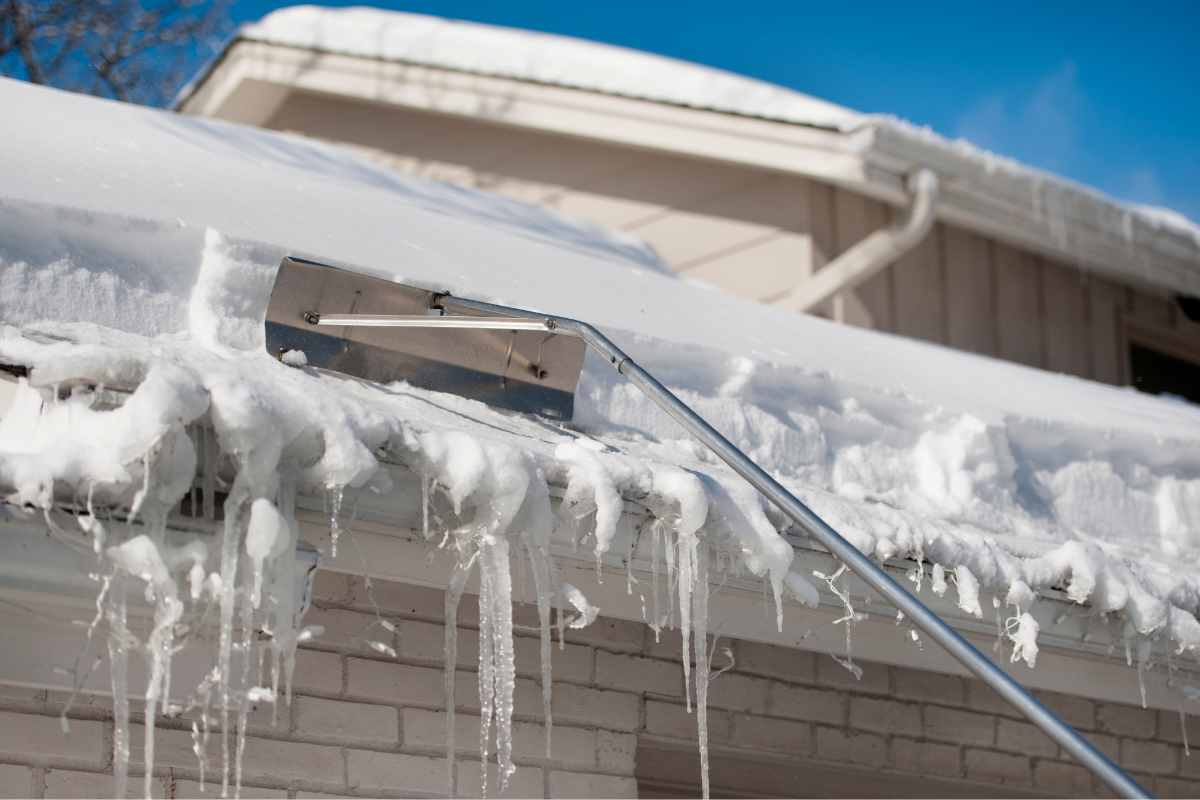Keeping Winter Woes at Bay: Preventing Ice Dams with Roof and Gutter Maintenance

As winter settles in and snow begins to blanket our homes, it’s essential to take proactive measures to protect our roofs from the threat of ice dams. These pesky formations can wreak havoc on our homes, causing water damage, leaks, and even structural issues if left unchecked. But fear not! With proper roof and gutter cleaning, you can safeguard your home against ice dams and enjoy a worry-free winter season. In this blog, we’ll explore some practical winterization tips to prevent ice dams and keep your home cozy and dry all season long.
Understanding Ice Dams: The Culprit of Winter Woes
Before we dive into prevention strategies, let’s take a moment to understand what exactly ice dams are and how they form. Ice dams are ridge-like formations of ice that build up along the edges of roofs, typically in colder climates where snow accumulates. These dams form when heat from the interior of a home melts snow on the roof, causing it to trickle down and refreeze at the roof’s edge, where temperatures are cooler. Over time, this process creates a barrier of ice that prevents water from draining properly, leading to potential leaks and water damage inside the home.
Clearing the Way: Keep Your Gutters Clean
One of the most effective ways to prevent ice dams is by ensuring that your gutters are clear of debris and obstructions. Clogged gutters can trap water and prevent it from draining properly, increasing the likelihood of ice dams forming along the roofline. Make it a priority to regularly clean out your gutters, especially during the fall when leaves and debris are abundant. Consider installing gutter guards to help prevent debris buildup and minimize the need for frequent cleaning.
Insulating Your Attic: Maintain Proper Temperature Control
Proper attic insulation and ventilation play a crucial role in preventing ice dams by regulating the temperature of your roof. A well-insulated attic helps to maintain a consistent temperature throughout your home, reducing the likelihood of snow melting and refreezing on the roof’s surface. Inspect your attic for signs of inadequate insulation, such as drafts or cold spots, and consider adding additional insulation if necessary. Additionally, ensure that your attic is properly ventilated to allow excess heat and moisture to escape, reducing the risk of ice dam formation.
Sealing Leaks and Gaps: Protecting Your Home’s Integrity
Leaks and gaps in your home’s exterior can contribute to heat loss and create hot spots on your roof, increasing the likelihood of ice dam formation. Take the time to inspect your roof and exterior walls for any signs of leaks, cracks, or gaps, and seal them promptly to prevent warm air from escaping. Pay particular attention to areas around chimneys, vents, and skylights, as these are common areas where leaks can occur. By sealing these vulnerabilities, you’ll help maintain a consistent temperature on your roof and minimize the risk of ice dam formation.
Removing Snow Safely: A Delicate Balance
While it may be tempting to grab a shovel and start clearing snow off your roof at the first sign of accumulation, it’s essential to approach snow removal with caution. Improper snow removal techniques can damage your roof and increase the risk of ice dams forming. If you do choose to remove snow from your roof, use a roof rake or plastic shovel to gently push snow off the roof, taking care not to damage shingles or gutters in the process. Avoid using metal tools or sharp objects, as these can cause scratches and punctures that compromise your roof’s integrity.
Installing Heat Cables: A Preventative Measure
For homes with a history of ice dam formation or in areas prone to heavy snowfall, installing heat cables along the roofline can be an effective preventative measure. Heat cables are designed to melt snow and ice along the roof’s edge, preventing the formation of ice dams and allowing water to drain freely. These cables can be installed along the eaves and gutters and activated when snow accumulation reaches a certain threshold. While heat cables can be an investment, they provide peace of mind and protection against potential water damage caused by ice dams.
Utilizing Ice Dam Prevention Products: Protective Measures
In addition to heat cables, there are various ice dam prevention products available on the market that can help protect your home from the damaging effects of ice dams. Ice dam membranes, for example, are installed along the roof’s edge and act as a barrier to prevent water from seeping under shingles and causing leaks. Similarly, ice melt pellets or tablets can be placed in gutters and downspouts to help melt ice and snow, allowing water to flow freely and reduce the risk of ice dam formation.
Consulting with Professionals: Expert Advice
If you’re unsure about the best approach to preventing ice dams or gutter and roof cleaning, don’t hesitate to consult with professionals. Roofing contractors and gutter specialists can provide expert advice and recommendations tailored to your home’s specific needs. Schedule a professional inspection and maintenance service before the onset of winter to identify any potential issues and address them proactively. Investing in professional maintenance now can save you time, money, and headaches down the road.
Conclusion: Winter-Ready and Worry-Free
With proper roof and gutter cleaning, you can protect your home against the threat of ice dams and enjoy a cozy, worry-free winter season. By keeping your gutters clean, insulating your attic, sealing leaks and gaps, and practising safe snow removal techniques, you’ll minimize the risk of ice dam formation and safeguard your home against water damage and leaks. Take the time to winterize your home now, and you’ll reap the rewards of a warm, dry, and comfortable living space all season long.





